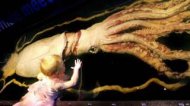Monsters News
 Sea monsters are the stuff of legend - lurking not just in the depths of the oceans, but also the darker corners of our minds. What is it that draws us to these creatures, asks Mary Colwell.
Sea monsters are the stuff of legend - lurking not just in the depths of the oceans, but also the darker corners of our minds. What is it that draws us to these creatures, asks Mary Colwell.
"This inhuman place makes human monsters, " wrote Stephen King in his novel The Shining. Many academics agree that monsters lurk in the deepest recesses, they prowl through our ancestral minds appearing in the half-light, under the bed - or at the bottom of the sea.
"They don't really exist, but they play a huge role in our mindscapes, in our dreams, stories, nightmares, myths and so on, " says Matthias Classen, assistant professor of literature and media at Aarhus University in Denmark, who studies monsters in literature. "Monsters say something about human psychology, not the world."
One Norse legend talks of the Kraken, a deep sea creature that was the curse of fishermen. If sailors found a place with many fish, most likely it was the monster that was driving them to the surface. If it saw the ship it would pluck the hapless sailors from the boat and drag them to a watery grave.
This terrifying legend occupied the mind and pen of the poet Alfred Lord Tennyson too. In his short 1830 poem The Kraken he wrote: "Below the thunders of the upper deep, / Far far beneath in the abysmal sea, / His ancient, dreamless, uninvaded sleep / The Kraken sleepeth."
The deeper we travel into the ocean, the deeper we delve into our own psyche. And when we can go no further - there lurks the Kraken.
Most likely the Kraken is based on a real creature - the giant squid. The huge mollusc takes pride of place as the personification of the terrors of the deep sea. Sailors would have encountered it at the surface, dying, and probably thrashing about. It would have made a weird sight, "about the most alien thing you can imagine, " says Edith Widder, CEO at the Ocean Research and Conservation Association.
"It has eight lashing arms and two slashing tentacles growing straight out of its head and it's got serrated suckers that can latch on to the slimiest of prey and it's got a parrot beak that can rip flesh. It's got an eye the size of your head, it's got a jet propulsion system and three hearts that pump blue blood."
Find out more
Image caption The tentacle of a giant squid, © The Trustees of NHM, LondonThe giant squid continued to dominate stories of sea monsters with the famous 1870 novel, Twenty Thousand Leagues Under the Sea, by Jules Verne. Verne's submarine fantasy is a classic story of puny man against a gigantic squid.
The monster needed no embellishment - this creature was scary enough, and Verne incorporated as much fact as possible into the story, says Emily Alder from Edinburgh Napier University. "Twenty Thousand Leagues Under the Sea and another contemporaneous book, Victor Hugo's Toilers of the Sea, both tried to represent the giant squid as they might have been actual zoological animals, much more taking the squid as a biological creature than a mythical creature." It was a given that the squid was vicious and would readily attack humans given the chance.
Image caption James Mason in the 1954 film 20, 000 Leagues Under the Sea © Everett Collection/REXбет боом
You might also like







